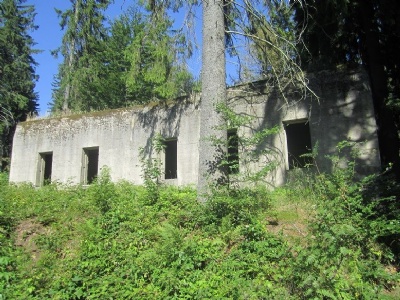Anlage Riese
Anlage Riese is the name of a large tunnel complex located in the Sowie mountains, southwestern Poland. When construction began in 1943, the Sowie Mountains belonged to Germany and were located in lower Silesia. Between November 1943 and February 1945, huge tunnel complexes were built at seven different sites, Wlodarz, Osowka, Sokolec, Sobon, Rzeczka, Jugowice and Ksiaz. Some tunnels were completed, others were not. The project was called Riese which in German means Gigantic. Looking at the construction the project may have had an industrial purpose. It is reminiscent of the war-producing industries that were placed inside mountains in Germany, Dora-Mittelbau in Nordhausen for instance. A rumor that has arisen is that the Germans planned to build miracle weapons. Other rumours claim that these miracle weapons were in fact nuclear weapons and that the Germans were in a process to build, or at least research, a nuclear bomb at Riese. These rumours has neveer benn confirmed and is most likely just rumours. Another theory is that the site would be a huge FHQ for Hitler and the top military leadership from which Hitler would lead the war. But all this is just speculation, but have for sure created a mystique about the place. What we do know is that Hitler never visited Riese.
The slave labor that was used to construct the tunnels came from Gross Rosen Concentration Camp, about 100 kilometres north od Riese. The prisoners were housed in four satellite camps Wüstegiersdorf, Dornau, Oberwüstegiersdorf and Wüstewaltersdorf. All four camps were subordinated to Gross-Rosen. How many people worked on the complex is not known, nor how many thousands of prisoners died during the work. The complex is over 35 square kilometers in size and until 2009 seven tunnel complexes have been discovered. It is believed that there may be more yet undiscovered tunnels. The tunnels that have been discovered have not been fully explored. When the Soviet Union conquered the area and the tunnels were discovered, they were thoroughly explored, but after this they were left to their fate. As a result, the tunnels were looted.
A few kilometers southeast of Rzeczka at Ludwikowice Klodzkie, is another mythical place that belonged to Riese. Exactly what was done on the site no one knows for sure, but it has created a myth that the Nazis were up to something. One theory put forward by the Polish writer, Igor Witkowski, is that the Nazis conducted experiments with an object resembling a large church bell (Die Glocke). Witkowski argues that the Germans experimented with a form of ”antigravity” that would allow visual time travel. Other theories speculate that the clock could have been some form of escape capsule for Nazis who wanted to escape justice. The Bell is said to be runned by radioactive substances, which meant that several of the researchers who worked with the Bell lost their lives as a result of radiation. There is no evidence whatsoever about these deaths. At this site there is a large circular construction that Witkowski believes could be the ruins of the test facility where the Bell was tested. But the construction could also be as undramatic as a dilapidated industrial plant that has nothing whatsoever to do with Nazi top-secret experiments. Where the clock itself and those who worked on it would have gone after the war is also a subject of myths and speculation.
Current status: Partly preserved/demolished with museum (2011).
Location: 50°40'10.43" N 16°25'06.86" E
Get there: Car.
Follow up in books: Seidler, Franz W. & Zeigert, Dieter: Hitler’s secret headquarters (2004).


























In 1995, private stakeholders took over three of the tunnel complexes, Osowka, Wlodarz and Rzeczka, and opened them up to visitors. The tunnel complexes are characterized by a tourism built on the mystery that surround the site. The sites are sometimes marketed as Hitler’s bunker although he sat his foot there. But Hitler sells, simple as that. The most interesting site to visit is Osowka, in addition to the tunnels there are also ruins after a factory on a mountain hill above the tunnels. In 2013, the construction was also in full swing with another tunnel museum at Die Glocke.